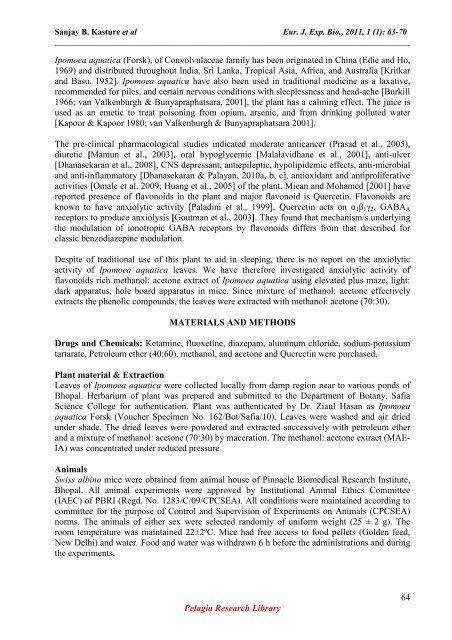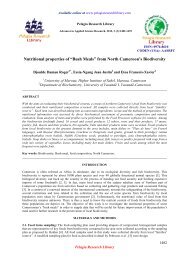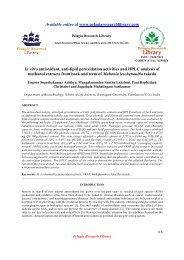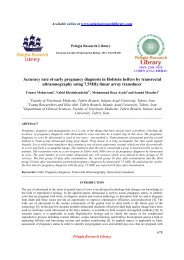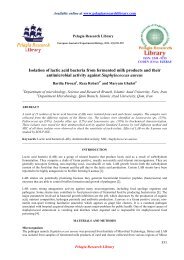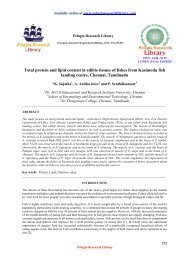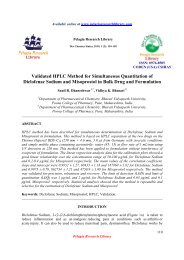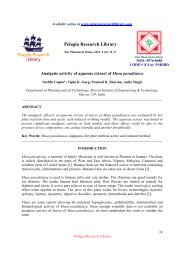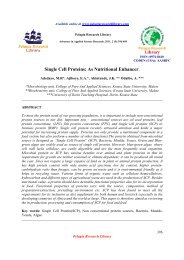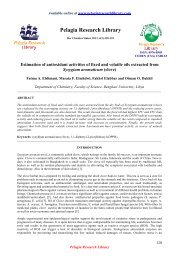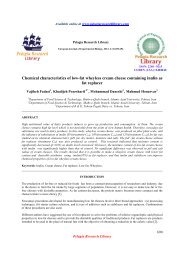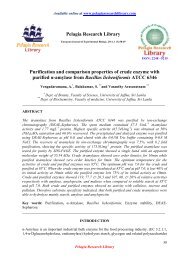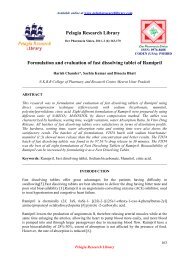Anxiolytic activity of Ipomoea aquatica leaves - Pelagia Research ...
Anxiolytic activity of Ipomoea aquatica leaves - Pelagia Research ...
Anxiolytic activity of Ipomoea aquatica leaves - Pelagia Research ...
Create successful ePaper yourself
Turn your PDF publications into a flip-book with our unique Google optimized e-Paper software.
Sanjay B. Kasture et al Eur. J. Exp. Bio., 2011, 1 (1): 63-70<br />
______________________________________________________________________________<br />
<strong>Ipomoea</strong> <strong>aquatica</strong> (Forsk), <strong>of</strong> Convolvulaceae family has been originated in China (Edie and Ho,<br />
1969) and distributed throughout India, Sri Lanka, Tropical Asia, Africa, and Australia [Kritkar<br />
and Basu, 1952]. <strong>Ipomoea</strong> <strong>aquatica</strong> have also been used in traditional medicine as a laxative,<br />
recommended for piles, and certain nervous conditions with sleeplessness and head-ache [Burkill<br />
1966; van Valkenburgh & Bunyapraphatsara, 2001], the plant has a calming effect. The juice is<br />
used as an emetic to treat poisoning from opium, arsenic, and from drinking polluted water<br />
[Kapoor & Kapoor 1980; van Valkenburgh & Bunyapraphatsara 2001].<br />
The pre-clinical pharmacological studies indicated moderate anticancer (Prasad et al., 2005),<br />
diuretic [Mamun et al., 2003], oral hypoglycemic [Malalavidhane et al., 2001], anti-ulcer<br />
[Dhanasekaran et al., 2008], CNS depressant, antiepileptic, hypolipidemic effects, anti-microbial<br />
and anti-inflammatory [Dhanasekaran & Palayan, 2010a, b, c], antioxidant and antiproliferative<br />
activities [Omale et al. 2009; Huang et al., 2005] <strong>of</strong> the plant. Miean and Mohamed [2001] have<br />
reported presence <strong>of</strong> flavonoids in the plant and major flavonoid is Quercetin. Flavonoids are<br />
known to have anxiolytic <strong>activity</strong> [Paladini et al., 1999]. Quercetin acts on α 1 β 1 γ 2s GABA A<br />
receptors to produce anxiolysis [Goutman et al., 2003]. They found that mechanism/s underlying<br />
the modulation <strong>of</strong> ionotropic GABA receptors by flavonoids differs from that described for<br />
classic benzodiazepine modulation.<br />
Despite <strong>of</strong> traditional use <strong>of</strong> this plant to aid in sleeping, there is no report on the anxiolytic<br />
<strong>activity</strong> <strong>of</strong> <strong>Ipomoea</strong> <strong>aquatica</strong> <strong>leaves</strong>. We have therefore investigated anxiolytic <strong>activity</strong> <strong>of</strong><br />
flavonoids rich methanol: acetone extract <strong>of</strong> <strong>Ipomoea</strong> <strong>aquatica</strong> using elevated plus maze, light:<br />
dark apparatus, hole board apparatus in mice. Since mixture <strong>of</strong> methanol: acetone effectively<br />
extracts the phenolic compounds, the <strong>leaves</strong> were extracted with methanol: acetone (70:30).<br />
MATERIALS AND METHODS<br />
Drugs and Chemicals: Ketamine, fluoxetine, diazepam, aluminum chloride, sodium-potassium<br />
tartarate, Petroleum ether (40:60), methanol, and acetone and Quercetin were purchased.<br />
Plant material & Extraction<br />
Leaves <strong>of</strong> <strong>Ipomoea</strong> <strong>aquatica</strong> were collected locally from damp region near to various ponds <strong>of</strong><br />
Bhopal. Herbarium <strong>of</strong> plant was prepared and submitted to the Department <strong>of</strong> Botany, Safia<br />
Science College for authentication. Plant was authenticated by Dr. Ziaul Hasan as <strong>Ipomoea</strong><br />
<strong>aquatica</strong> Forsk (Voucher Specimen No. 162/Bot/Safia/10). Leaves were washed and air dried<br />
under shade. The dried <strong>leaves</strong> were powdered and extracted successively with petroleum ether<br />
and a mixture <strong>of</strong> methanol: acetone (70:30) by maceration. The methanol: acetone extract (MAE-<br />
IA) was concentrated under reduced pressure<br />
Animals<br />
Swiss albino mice were obtained from animal house <strong>of</strong> Pinnacle Biomedical <strong>Research</strong> Institute,<br />
Bhopal. All animal experiments were approved by Institutional Animal Ethics Committee<br />
(IAEC) <strong>of</strong> PBRI (Regd. No. 1283/C/09/CPCSEA). All conditions were maintained according to<br />
committee for the purpose <strong>of</strong> Control and Supervision <strong>of</strong> Experiments on Animals (CPCSEA)<br />
norms. The animals <strong>of</strong> either sex were selected randomly <strong>of</strong> uniform weight (25 ± 2 g). The<br />
room temperature was maintained 22±2ºC. Mice had free access to food pellets (Golden feed,<br />
New Delhi) and water. Food and water was withdrawn 6 h before the administrations and during<br />
the experiments.<br />
<strong>Pelagia</strong> <strong>Research</strong> Library<br />
64


